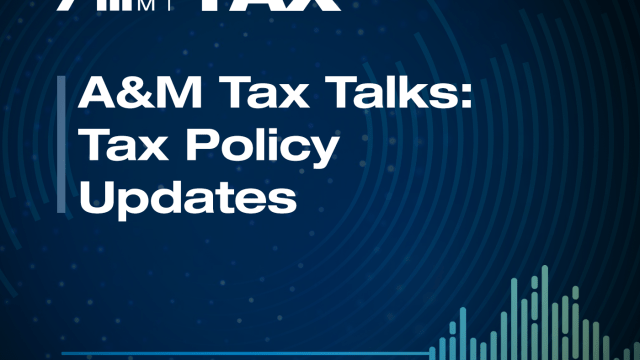Shifting Tax Policies: Impacts of the 'America First Investment Policy' and the Entry Into Force of the Double Taxation Agreement Between Italy and China
A China Tax Perspective
On February 21, 2025, U.S. President Donald Trump signed the “America First Investment Policy” memorandum to restrict Chinese-affiliated investments in critical sectors of the American economy. As part of this initiative, the Trump administration plans to review the 1984 United States-The People’s Republic of China Income Tax Convention (U.S.-China DTA) to determine whether it should be suspended or terminated, citing concerns that the treaty has contributed to the deindustrialization of the U.S. and the technological modernization of the PRC military.[1]
In contrast, on March 6, 2025, the China State Taxation Administration (STA) announced that the Double Taxation Agreement between Italy and China (China-Italy DTA), signed on March 23, 2019, will take effect from February 19, 2025, and will be applicable starting January 1, 2026. This agreement aims to prevent double taxation on income, thereby fostering a more favourable environment for business and investment. By strengthening its international tax treaties, China signals its commitment to attracting foreign investment amid a shifting global economic landscape.[2]
The juxtaposition of China's proactive approach and the U.S.’s restrictive policies highlights a significant transformation in international economic relations, with potential implications for cross-border trade and investment. In light of these developments, the following considerations from a China tax perspective should be taken into account by both corporations and individuals, especially those operating in critical sectors or involved in related investments.
Impacts of the 'America First Investment Policy' From a China Tax Perspective
1. Withholding Tax (WHT) Charged on Passive Income
Under China domestic tax laws and regulations, a 10 percent WHT is imposed on passive income (i.e., dividends, royalties, interest) paid to non-resident enterprises. Although the U.S.-China DTA[3] does not reduce this WHT rate, it stipulates that royalties paid for the rental of industrial, commercial or scientific equipment are taxed on 70 percent of the gross amount. If the U.S.-China DTA is terminated, this benefit will no longer be available.
A&M observations: The suspension or termination of the U.S.-China DTA would lead to higher tax costs for non-resident enterprises, particularly those involved in renting industrial, commercial or scientific equipment. This could impact investment decisions and business operations between the two countries.
2. Capital Gain Taxes on Equity Disposal
Under China domestic tax laws and regulations, a 10 percent withholding CIT is imposed on capital gains from the disposal of equity interests in Chinese companies by non-resident enterprises. However, under the U.S.-China DTA, these capital gains may be exempted from China CIT if the Chinese company being disposed of is not land-rich (broadly, its assets do not primarily consist of immovable properties located in China) and the U.S. company's shareholding percentage is less than 25 percent before the disposal. If the U.S.-China DTA is terminated, this benefit will no longer be available.
A&M observations: If the current shareholding structure allows a potential tax-free disposal of Chinese companies under the U.S.-China DTA, we recommend that U.S. companies closely monitor related developments and consider if there could be a more tax-effective structure to hold the Chinese companies to the extent commercially feasible, subject to tax avoidance and treaty shopping considerations.
3. Dual Residency Status
According to the U.S.-China DTA, if an individual or a company is determined to be a tax resident in both jurisdictions under their respective domestic laws, the competent tax authorities of both jurisdictions should consult to resolve the issue. If the U.S.-China DTA is terminated, dual residency will inevitably result in double taxation. For instance, if a company is registered in the U.S. but its place of effective management is in China, the company is likely to be regarded as a dual tax resident enterprise.
A&M observations: Although Chinese enterprises and individuals can mitigate this risk by utilizing domestic tax regulations, such as claiming foreign tax credits for taxes paid in the other jurisdiction, it would likely give rise to additional compliance costs.
4. Taxable “Establishment” vs. Permanent Establishment (PE)
Under China domestic tax laws and regulations, a non-resident enterprise shall pay China CIT on income sourced within China from its establishment in China and on income sourced outside of China that is effectively connected with its establishment in China. The term “establishment” is broadly defined to include a place of management, an office, a place for the provision of labour services, business agents, etc. However, a U.S. resident enterprise could seek further protection from the U.S.-China DTA which takes precedence over the China domestic tax laws and regulations.
Under the U.S.-China DTA, a U.S. resident enterprise is subject to China CIT only if it has a PE in China. The U.S.-China DTA raises the threshold for constituting a PE. For instance, if a person is assigned from the U.S. to China by a U.S. company, the person is likely to constitute a taxable establishment in China (e.g., a place for the provision of labour services or an office if the person has a fixed place to work). However, this would not be considered a PE under the U.S.-China DTA if the place for the provision of labour services or the office lasts no more than six months in aggregate within any 12-month period. Additionally, activities of a preparatory or auxiliary nature are likely to be considered taxable establishments under China domestic tax laws and regulations, while the term “PE” under the U.S.-China DTA excludes such activities. Furthermore, if a U.S. company conducts construction, assembly or installation projects, or supervisory activities related to them, these are likely to constitute taxable establishments under China domestic tax laws and regulations, but not a PE under the U.S.-China DTA if the projects or activities last no more than six months.
5. “183-Day” Rule
According to the U.S.-China DTA, U.S. tax residents working in China can be exempt from China individual income tax (IIT) on their China-sourced income if they stay in China for a period or periods not exceeding 183 days in aggregate in a calendar year, provided certain conditions are met. However, if the U.S.-China DTA is terminated, under Chinese domestic law, U.S. tax residents working in China can only be exempt from China IIT on their China-sourced income if they reside in China for less than 90 days within a tax year and the income is paid by an overseas entity or individual.
A&M observation on Numbers 4 and 5: The termination of the U.S.-China DTA may adversely affect U.S. executives stationed in China, employees seconded to China, technical staff temporarily dispatched to China for specific projects, etc. We recommend that U.S. companies closely monitor related developments and timely adjust their secondment arrangements accordingly.
Impacts of the Entry Into Force of the Double Taxation Agreement Between Italy and China From a China Tax Perspective
1. More Favourable WHT Rates on Passive Income
The prevailing China-Italy DTA does not reduce the China domestic WHT rate of 10 percent on passive income (i.e., dividends, royalties, interest) paid to non-resident enterprises. The new China-Italy DTA[4] introduces more favourable WHT rates. In particular:
- 5 percent WHT rate for dividends if certain conditions are met (e.g., beneficial ownership requirement and minimum equity holding of 25 percent for over 365 days);
- 8 percent WHT rate for interest if the interest is paid to a financial institution on a loan with a term of at least three years for the financing of investment projects;
- While the WHT rate for royalties will remain at 10 percent, royalties paid for the use of, or the right to use, industrial, commercial or scientific equipment will be taxed on 50 percent of the gross amount, i.e., effectively a 5 percent WHT rate.
A&M observations: The 5 percent WHT rate for dividends is consistent with the rates provided by DTAs between China and other jurisdictions in Europe and Asia, such as Germany, France, the United Kingdom, Switzerland, Sweden, Hong Kong and Singapore. Additionally, the 8 percent WHT rate for interest is lower than the rates provided by most other DTAs with China (typically 10 percent), except for a few jurisdictions such as Hong Kong, Macau and Singapore, which provide a 7 percent WHT rate for interest. Furthermore, the effective 5 percent WHT rate for certain royalties is lower than the effective rates provided by most other DTAs with China (generally 10 percent on 60 percent or 70 percent of the gross amount), except for a few jurisdictions such as Hong Kong and Macau (where the WHT rate is 5 percent and 7 percent for different types of royalties), and Switzerland (where the WHT rate is 9 percent). On balance, the new China-Italy DTA introduces more favourable tax rates, which can enhance cross-border investments and economic cooperation between the two countries. These changes are likely to reduce the tax burden on non-resident enterprises and encourage long-term investments.
2. Definition of PEs
The new China-Italy DTA raises the threshold for establishing a construction PE[5] by changing the duration requirement from “more than six months” to “more than twelve months.” Additionally, the threshold for establishing a service PE[6] has been refined from six months to 183 days.
A&M observations: In the 1980s, China's tax treaties with other jurisdictions commonly used a six-month standard for both construction PEs and service PEs. In tax treaties signed in the new century, the standard for construction PEs has generally shifted to 12 months, while the standard for service PEs has been adjusted to 183 days. According to the STA Announcement 2018 No. 11, the time requirement for service activities to constitute a PE was revised from "six months" to "183 days." The changes in the China-Italy DTA are consistent with this trend.
[1] “America First Investment Policy,” Executive Memorandum, The White House, February 21, 2025, https://www.whitehouse.gov/presidential-actions/2025/02/america-first-investment-policy/
[2] Public Notice 6, China State Taxation Administration, March 6, 2025, https://fgk.chinatax.gov.cn/zcfgk/c100012/c5239047/content.html
[3] “United States-The People’s Republic of China Income Tax Convention,” April 30, 1984, Entered into Force January 1, 1987, Internal Revenue Service, https://www.irs.gov/pub/irs-trty/china.pdf
[4] Double Taxation Agreement between Italy and China, March 23, 2019, Entered into Force February 19, 2025, China State Taxation Administration, https://www.chinatax.gov.cn/chinatax/n810341/n810770/c4210610/5027091/files/%E6%84%8F%E5%A4%A7%E5%88%A9%E6%96%B0%E5%8D%8F%E5%AE%9A.pdf
[5] According to the OECD Model Convention, a building site or construction or installation project constitutes a PE (construction PE) if it lasts more than 12 months. According to the UN Model Convention, a “construction PE” is defined as a building site, a construction, assembly or installation project or supervisory activities in connection therewith, but only if such site, project or activities last more than six months.
[6] According to the UN Model Convention, a “service PE” is defined as the furnishing of services, including consultancy services, by an enterprise through employees or other personnel engaged by the enterprise for such purpose, but only if activities of that nature continue (for the same or a connected project) within a Contracting State for a period or periods aggregating more than 183 days in any 12-month period commencing or ending in the fiscal year concerned.




